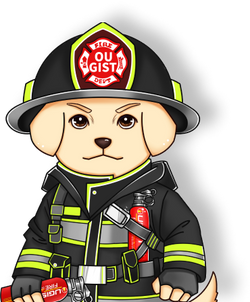
Fire is a powerful and destructive force that can pose significant risks to life and property. To combat fires effectively, it is essential to understand the different classes of fires and use the appropriate fire extinguishers. The ABC fire types categorize fires based on the materials that fuel them. In this blog, we will explore the ABC fire types and the extinguishers best suited for each class.
Class A Fires:
Class A fires involve ordinary combustible materials such as wood, paper, cloth, plastics, and other common materials found in homes and offices. These fires are characterized by the presence of glowing embers and tend to leave behind ash and debris.
Extinguishing Class A Fires:
For Class A fires, the most suitable fire extinguisher is labeled as "ABC." These multipurpose extinguishers contain dry chemical agents like monoammonium phosphate or ammonium sulfate. When discharged, the agent coats the burning material, cutting off the fire's oxygen supply and effectively smothering the flames.
Class B Fires:
Class B fires involve flammable liquids or gases, such as gasoline, oil, grease, alcohol, and propane. These fires can spread quickly and are known for their ability to reignite if not adequately extinguished.
Extinguishing Class B Fires:
For Class B fires, specific fire extinguishers are labeled "BC." These extinguishers use a dry chemical agent called sodium bicarbonate or potassium bicarbonate. Similar to Class A extinguishers, the agents work by creating a barrier between the fire and the oxygen it needs to sustain itself.
Class C Fires:
Class C fires involve energized electrical equipment, such as appliances, power tools, and electrical outlets. These fires can be particularly hazardous as water-based extinguishers can conduct electricity and worsen the situation.
Extinguishing Class C Fires:
The most suitable fire extinguisher for Class C fires is the "ABC" multipurpose extinguisher. It can safely handle Class A, Class B, and limited Class C fires. It is essential to shut off the power source before attempting to extinguish a Class C fire.
Class D Fires:
Class D fires involve combustible metals, such as magnesium, titanium, potassium, sodium, and lithium. These fires are less common but can be extremely challenging to extinguish due to the unique properties of the burning metals.
Extinguishing Class D Fires:
Class D fires require specialized extinguishers designed for the specific metal involved. These extinguishers use dry powder agents, specifically formulated to smother and cool the burning metal.

Conclusion:
Understanding the ABC fire types and their respective fire extinguishers is crucial for effective fire safety. Having the right extinguisher on hand can make a significant difference during a fire emergency, preventing the fire from spreading and minimizing potential damage. Remember to conduct regular fire extinguisher inspections and ensure that all occupants of your home or workplace are familiar with their proper usage. By being prepared and knowledgeable, we can better protect ourselves and our surroundings from the dangers of fire.
Stay safe and be fire-aware!


